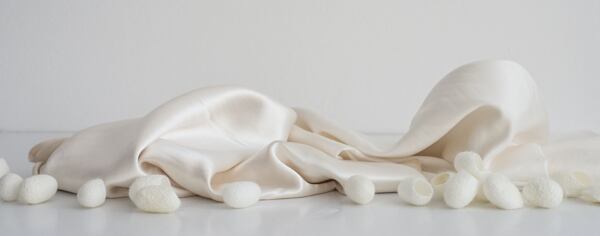
The ancient secret of how silk is made revealed
It’s hard to believe that the secret of silk production was kept for so long. Like so many other great discoveries, this one seems to have happened by accident. An ancient Chinese legend tells us that four thousand years ago, an empress was enjoying her tea in a garden full of mulberries when a cocoon fell into her cup. Fishing it out, she caught the end of the silk filament and found herself unraveling the cocoon.
We’ll never know if there’s any truth to the story, but the fact is that if you try the same thing at home, you’re pretty much certain to succeed. A cocoon does come apart in warm water. All you have to do is find the end of the filament and pull. Of course, it will take you a while to find the end and then you’ll have to unwind and unwind and unwind for a very long time…. about 1,000 meters long (that’s almost 11 American football fields lined up end to end).
Of course, human ingenuity knows no bounds, especially when it comes to saving work. So, weary of unraveling cocoons by hand, our ancestors dreamed up the reeling mill. There used to be mills all over Europe – Lyon, Genoa, Valencia – and even countries with colder climes, like the UK and Germany, had silk reeling mills of their own. These days, however, most of the world’s reeling mills are located in areas where natural silk is produced locally – China and India – so the chance to visit one doesn’t crop up every day.
So, you can imagine that I jumped at the opportunity when it presented itself. I was on a silk trip to the south Indian state of Karnataka. Having visited a cocoon market already, my interest was piqued and I wanted to see what happens next. Once again, our local expert on all things silk, Divakar, arranged the excursion and provided valuable insight.
Indian silk fabrics
Our Indian silks are made exclusively for Sartor Bohemia without any third parties. We support small, family weavers that we have selected personally.
Visiting a reeling mill in Karnataka to see how silk is made
I had to get up pretty early to fall into the rhythm of the Indian workday. It starts at the break of dawn so that people can get something done before the heat sets in. At about the time when I usually wake my kids for school, we’ve been on the road for an hour and we’re just pulling up in front of a big building somewhere in the Indian countryside.
Sorting cocoons
We greet the mill’s caretaker and head off for our tour of the production area. We step through a huge portal, leaving the sun-filled courtyard behind, and enter the twilight of the first hall. As my eyes adjust to the dim light, what I see reminds me of the cocoon market – the floor is flooded with mounds of silk cocoons piled on hemp sacks as far as the eye can see. If I felt like I was lost in a sea of silk cocoons at the cocoon market, here it was more like an ocean.

“The cocoons were brought here as soon as the sale was closed at the cocoon market. Since they’re sold with live pupae inside, they have to be processed at the factory within two or three days, before the silk moth emerges, which would break the side of the cocoon and tear the endless thread. The whole process has to be perfectly timed and there’s no room for delay,” explains Divakar.
In the midst of this sea of silk, several women are seated on the ground, deftly sorting cocoons. I can’t help thinking of Cinderella sorting peas and lentils by the hearth. The cocoons are sorted by quality. Aside from the perfect, smooth, white cocoons, there are always a certain percentage in every batch that don’t meet the mark and have to be put aside. Divakar explains that the rejects include damaged, crushed or broken cocoons and also those that have been dirtied by adult silk moths – the cocoons with the brown stains. Undersized cocoons belong in this category too, the ones that don’t have the ideal thousand meters of silk, as do cocoons whose pupae have died (experienced hands can tell by a shake). Double cocoons, produced by two silkworms together, are also put aside to make the ever popular dupioni silk. The rejects are not thrown away – everything is used, with nothing going to waste. They are turned into dupioni silk or lower quality silk yarns as well as silk floss filling for comforters. I also learn that dupioni, or rather the yarn for making it, is actually a by-product that doesn’t have its own dedicated reeling mills.
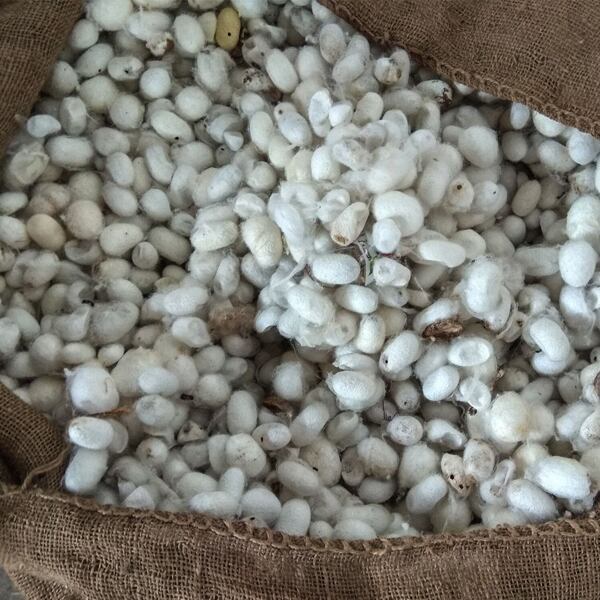

Less-than-perfect cocoons and those that have been damaged are set aside to make dupioni silk yarn
“Don’t forget that we’re working with a natural product whose quality varies. Dupioni and other lesser quality cocoons that are used for making dupioni silk are always a small portion that can’t be bought separately at the market and have to be sorted out from the classic lots in the sorting room. It’s not a large volume and they have to be processed by hand, which is more difficult. Dupioni yarns are always just a sideline really, a byproduct of silk reeling. Even though processing dupioni yarns is a difficult manual process and not very cost effective, we do it anyway – it’s not in line with our way of thinking to throw anything away. We have a respect for silk and for all living things and letting it go to waste would be disrespectful.”
It immediately strikes me how very much sericulture differs among various countries. While in China silk is a straight-up matter of business with production driven by an ever present demand, in India the economic factors of production are intertwined with ethical considerations, and in a place like Japan, where making silk has long been a non-profit venture, sericulture is viewed as a part of the cultural heritage and its production is subsidized by the state to keep it from disappearing forever.
Drying the cocoons
As we approach the next hall, a gust of hot air hints at what lies next. After the cocoons are sorted, they have to be dried. I’m standing beside a huge, wood-burning furnace and a long conveyer belt that takes up most of the space in the hall.
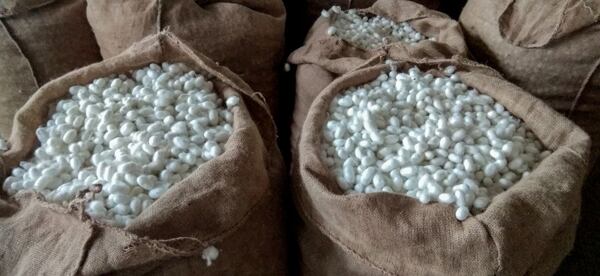
“The sorted cocoons are brought to this hall in big burlap sacks and emptied onto the belt. They move slowly through the dryer and in four hours they’re ready to store for up to three months. Drying them for five and a half hours extends their shelf life to a full year. We store the dried cocoons in burlap sacks in a dark, dry, well-ventilated place until we need them.”
The reeling process
We leave the heat of the drying room and move on to the next hall, where we find the heart of whole operation. This is where cocoons make the miraculous transformation into silk thread. Unraveling the silk filament from the cocoon evidently works on the very self-same principle discovered by that Chinese empress all those years ago. In front of me stands a huge cauldron of water swimming with silkworm cocoons. The bath is stirred by a huge arm with what looks like a bunch of paint brushes. The loosened filaments go out the other side. I understand the water bath, but I still can’t get my head around how some randomly moving brushes can tease the near invisible ends of silk filaments from soggy cocoons.
“First the cocoons are soaked in the water until they’re saturated and fall to the bottom. By nature, all silkworms, whether they’re mulberry silkworms or any other kind, they all make their cocoons by spinning glandular secretions (the silk filament) in the same direction and always in a figure eight. And that’s the trick. The stirring arm with the brushes traces the same figure eight in the tub, except in the opposite direction. Sooner or later the brush will catch the end of the silk filament and pull it loose.”

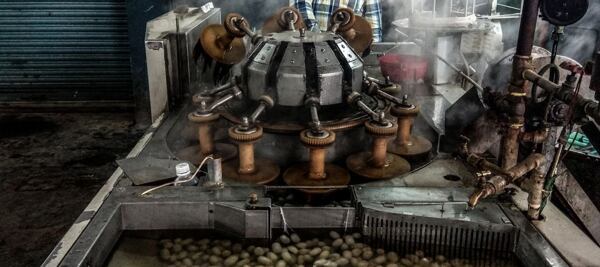
So, eight is the magic number! I guess it’s no wonder that eight is lucky in so many Asian cultures. At least in terms of how silk is made it seems to work some magic. I turn my attention from the brushes and watch the loosened silk filaments heading out the other end. The cocoons whose ends have been caught plop out into smallish tubs (the blue plastic tubs in the picture) and are taken to the reeling line.
“We take six to eight cocoons and put their ends together and unravel them at the same time. So a silk thread is always made of six to eight silk filaments. The resulting thread goes through this red gadget, which is a quality detector, and if the machine measures a decrease in the thickness of the thread, it activates a second gadget that automatically pulls another cocoon from the tub to add its filament to the thread.”
As you can see, the fineness of silk thread must be slightly variable. On top of that, each “endless” silk filament – about 1,000 meters long – has to be joined with another when it gets to the end. I’m starting to understand the Indian system of labelling silk thread thickness that I come across in my work. The system takes into account this variability. To show the quality of silk thread you’ll see markings like 20/22 (twenty to twenty-two), which allows leeway for variations in thickness.
The process of reeling thread from the cocoons is almost entirely automatic, except for the step of joining one thread to the next, which is done by hand. The highest quality thread can only be made with the unbroken central part of the cocoons.
“The first few meters of filament, from the surface of the cocoon, are often broken, and the filament closest to the pupa is even worse. That’s why the reeling machine always stops automatically and waits for the technician to trim the ends of the filaments being joined.”
Now I can see where the raw material comes from for the thread that goes into our ever popular and affordable spun silks. A material as valuable as silk is processed down to the very last bit, so all silk by-products are put to use. These exquisite, but short, filaments are aligned, brushed, and spun into a fairly regular schappe yarn. That process has its own by-products that are further processed into bourette yarn, which we know from our noil silks. This silk is not as lustrous or fine, but it has all of the other great qualities of silk… its breathability, feather lightness, and antibacterial properties, and the interesting, slubbed texture makes it a popular fashion fabric.

Once the whole filament has been unraveled from the silk cocoon, the dried pupa is revealed. To my surprise, there’s a use for that too.
“We don’t let anything go to waste here. Since we work with fresh cocoons, drying them and storing them in the proper conditions, our larvae are a very valuable source of healthy proteins. We sell them to factories that use them to make high quality fish food.”
Now that’s what I call waste-free operations J. It seems to me that it’s better to make full use of the silk cocoon compared to what happens with “peace silk”, where the moths emerge from their cocoons and then drop dead with exhaustion because, bred for size, they’re too big to fly off and find food.
Reeling the yarn
At first, it may seem that once the silk filaments are unraveled from the cocoons and reeled onto spools, that the job is done. But first impressions can be deceiving, and there are still several more halls ahead of me. In the next I see how the filament from the cocoons is re-reeled onto other spools.
“To make silk yarn into a final product, we have to reel the yarn again to produce a skein of uniform length, weight, fineness, and quality for a uniform price. In India, silk skeins have a standard length of 840 yards and the yarn is wrapped in a figure eight so that the fine silk doesn’t get tangled and the individual threads can be easily separated.”
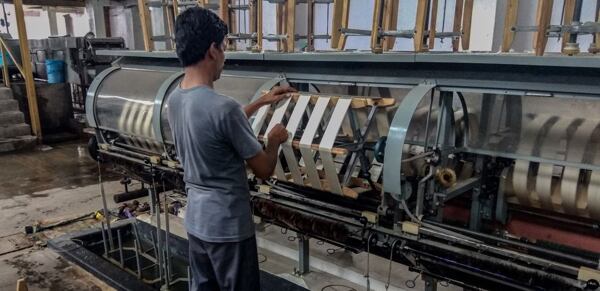
The number eight again! There must be something to it… Anyway, if you’ve ever tried weaving, you know that without the figure eight technique you won’t get anywhere. It’s a simple trick for preparing warp threads for warping in the right length without tangling.
Bundling the silk into skeins for silk fabric production
In the next hall, the standardized skeins are made into even larger skeins of silk – finally I see the big twists of raw silk lined up side by side that I know from our weavers’ storerooms and the silk markets. We conclude our excursion in a little room where the silk is bundled to ship out to the weavers.
Here I gratefully sink into a chair for a moment and some good soul offers me a cup of hot masala tea. As I sip the sweet drink a crate of skeins is brought in from the last hall. Two workers pack the skeins, five-wide, in a baling box, continuing until there are ten layers. Then they close the box and it ties the skeins in a sturdy bundle of fifty. And that’s the end of the line – the silk is ready to ship out. I’ve reached the end of the line too, so I thank our friendly guides and head back to my hotel to stretch out for a while and then write it all down.
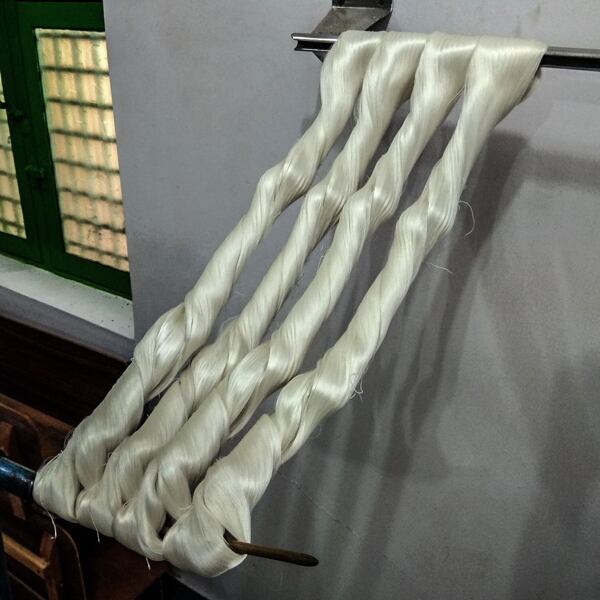
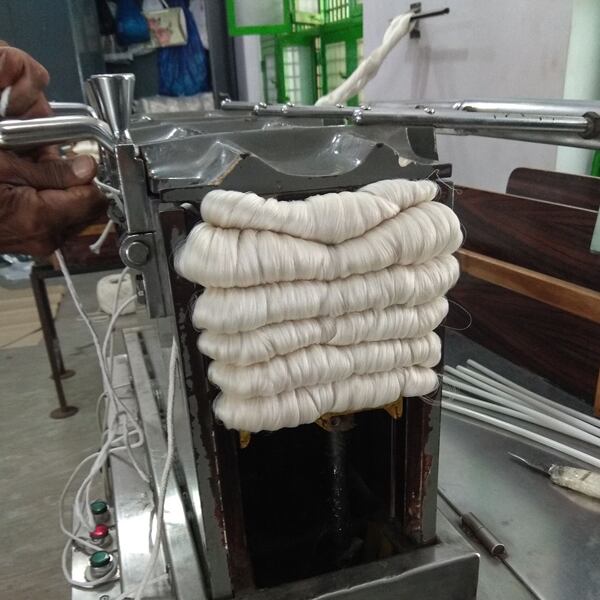

Uniform skeins of silk yarn are neatly packed in bundles of fifty
Treat silk with the respect and humility it deserves
Back home at Sartor, I remember my visit to the reeling mill whenever I pick up a length of silk fabric or a spool of thread. Natural silk has always held a certain magic and allure for me, but the more I know about this material, the more respect I have for it. I admire natural silk not just as a perfect natural material, but also as a meticulous product of human ingenuity. And to think, I’ve only described one of many long chapters in how silk is made. Someday I’d like to do a report on how our silk is woven too. And to make the silk story complete, I could visit the silk farmers who coax delicate mulberry trees to grow, creating ideal conditions for the silkworm that stands at the heart of it all.
Indian silk fabrics
Our Indian silks are made exclusively for Sartor Bohemia without any third parties. We support small, family weavers that we have selected personally.







Comments(0)